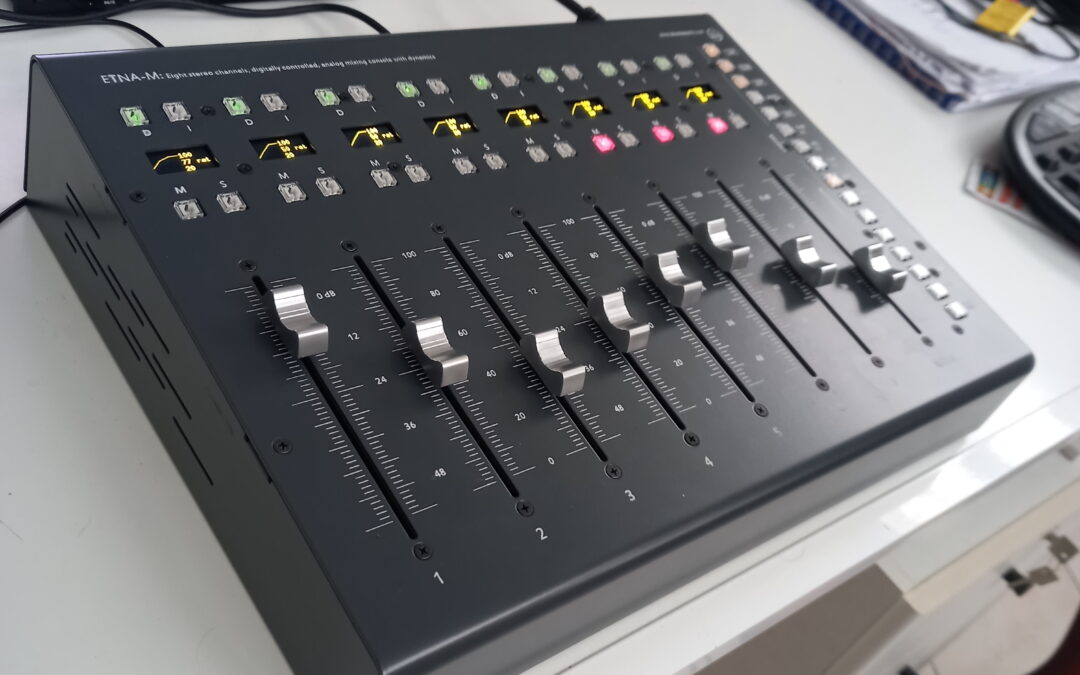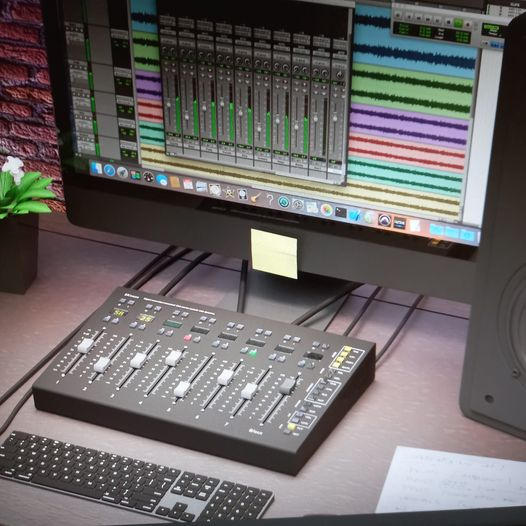
We are happy to announce Etna-M: our new analog, 8 stereo channels, motorised, total-recall, mixing console with full dynamics.
A full-analog audio path, summing into discrete op-amps and Carnhill audio transformers, with balanced inputs, sends and returns.
Eight 100mm, motorised, touch-sensitive faders for mixing and parameter control.
Total recall, external interface/editor, MIDI standard interface.
Full dynamics (limiter, compressor, expander) on each stereo channel and on master.
Four “ducking” busses for unique interaction among tracks, in any combination.
Total recall makes it the perfect tool for analog processing/mixing/summing with a DAW.
All the features, plus some additional metering, are replicated on the external editor.
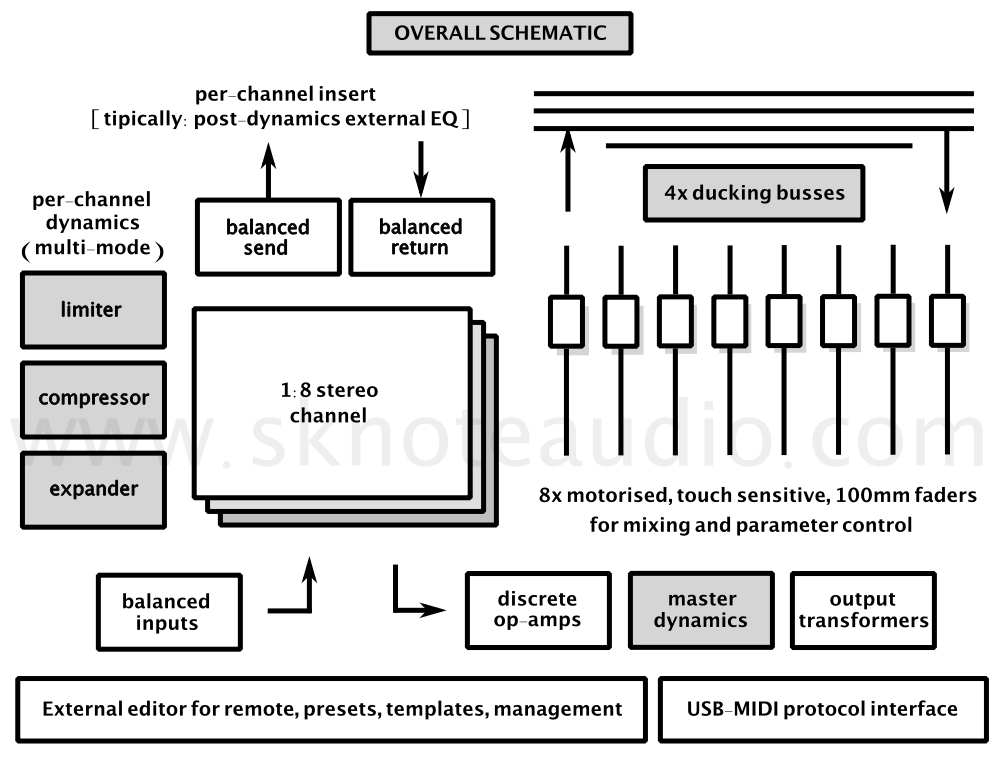
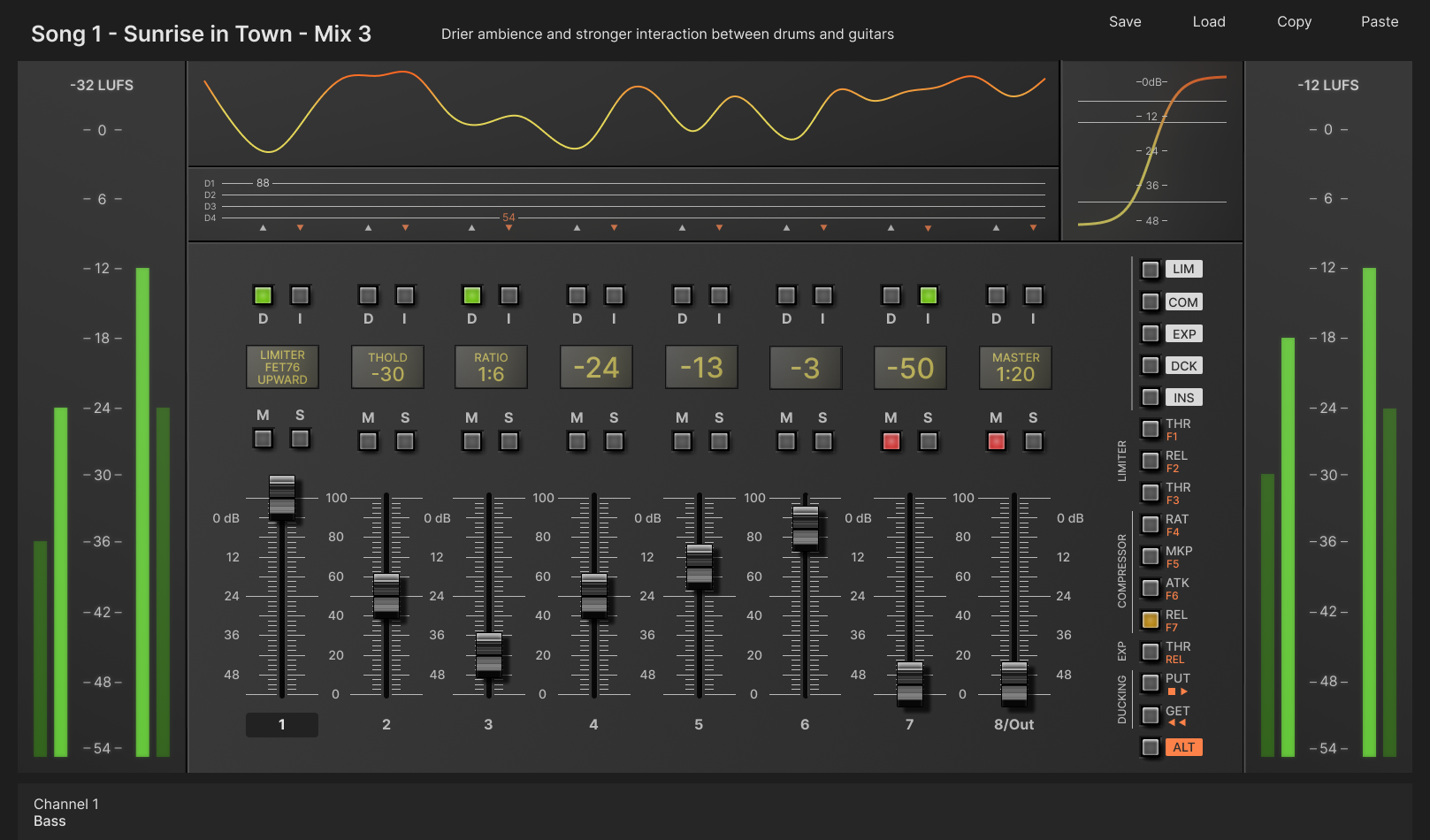
The editor runs in any modern browser, being extremely lightweight and portable.
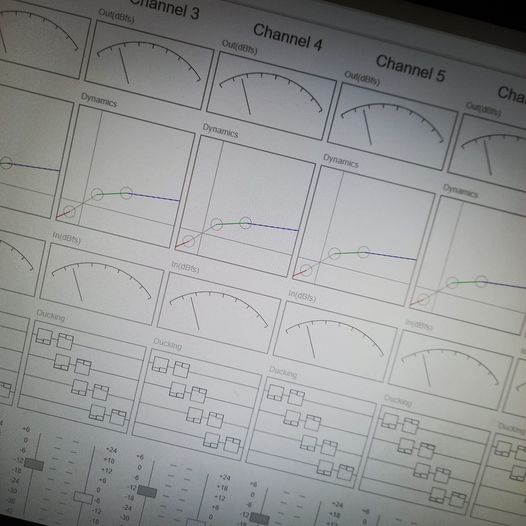
All the parameters are shown on a flat interface, giving an unprecedented control on an analog console.
FAQ (Frequently Asked Questions)
(Additional questions: please write to sales@sknoteaudio.com)
Q.: How to buy one unit?
A.: Write to sales@sknoteaudio.com, specifying the number of units you need. Current launch price tag is 2500 euro/USD each (VAT, taxes, shipment to be computed separately), with special price for multiple units. Delivery time is two weeks.
Q.: Can Etna-M be extended to more channels?
A.: Yes. Etna-M extension is available. It is identical to the main module but doesn’t include the summing module. Current price is 1999 euro/USD. (Please note that a full unit can be used as an extension, too).
Q.: Does the console rely on its external editor?
A: NO. The external editor is an available option (included) that makes interacting with a modern DAW (Digital Audio Workstation) simpler. The console is a completely independent hardware device.
Q.: Is the audio being converted to digital?
A: NO. The audio path is completely analog, through VCAs (Voltage Controlled Amplifiers), discrete op-amps (operational amplifiers, where the audio sum to a stereo mix happens) and audio transformers (for balancing and interfacing to outside world and, maybe, to get that analog mojo). Well, actually the only conversion of audio to digital is for the processed headphones output (headphones response calibration).
Q.: There is software involved. How can I ensure my investment is safe in the long term?
A.: The unit is completely self-contained. Switch it on and go. Any interfacing to software world is done through classic, well-established standards (MIDI, Mackie Control Protocol) so it is easily accessible from any compatible system like any modern DAW. Also, we’ve been in the hardware audio world for several years, now, including lots of places where you can’t see us. You can always contact us.
Q.: I read “8 x stereo channels”. What about mono channels?
A.: You can use any channel as mono, of course. We usually use a couple of D/A (Digital to Analog) converters for that (so, a stereo channel for a mono source, too), because it lets us manage the panning from inside the DAW. But that’s up to you.
Q.: What if I need more than 8 stereo channels today or will need more tomorrow?
A.: Units can be cascaded, both on digital (MIDI) and analog (audio sum) levels. Get two (or more) or add one later.
Q.: What about assistance?
A.: The unit is deeply modular inside and uses well diffused components. It usually is just about replacing a module and diagnosis is very simple. We offer direct assistance here (by shipment, like with our previous devices) and are working with distributors to build a small network of assistance points in other countries.
Q.: Do I need my mouse to control parameters (e.g. compressor attack on channel 3)?
A.: NO! The faders control ALL the parameters and provide (together with the screens) visual feedback. But you CAN use it if you like, by opening the editor. The editor is REALTIME. So you can. for example, move a fader also from there while programming automation.
Q.: How big is an unit?
A.: You can easily refer to the sizes listed in the specs. In any case, it is wide about like a small computer keyboard. Fader step (horizontal distance from a fader to the next one) is 40mm.
Q.: Do you only sell direct?
A.: Today: yes. Tomorrow: no. After a total stop due to lock-down times, we restarted with hardware from scratch, re-defined the management (including deals and solid partnerships) and decided to start from scratch with distributors. So we’ll probably go through distribution, too. The choice of purchasing directly from us or through re-sellers will be up to you. A distributor does also usually manage local assistance, though.
Q.: I love the concept but I’m a bit concerned about the price: how can you stuff all these things inside it with such a price tag?
A.: This is not black magic. It is clever design (very, if we may) and departing from old-style concepts, while getting the best out of old and well tested things like the op-amps and transformers. You get all of that but nothing is wasted. This is an unit you’ll absolutely love. Also, going direct or max through a single distribution layer helps.
Q.: Does the level mixing automation happen through DAW’s mixer?
A.: The console interfaces to the host by Mackie standard but that’s not the preferred way of using the connection for mix levels.
Using the console as a controller changes output levels through the DA converters.
The preferred way of mixing in analog world is having the DA converters to work at full range and make the levels in analog (so to keep full resolution).
So, the preferred way of dealing with mix level automation is to record the MIDI messages (volumes are pitch-bend messages), instead of interacting with host’s mixer. In playback, these messages will control the physical faders.
Q.: Does the unit feel solid?
A.: The case is a powder coated steel shell. No plastic.
Q.: How is the pinout of the D-sub connectors?
A.: It follows the Tascam standard for analog audio. From pin 1, on a single line: Hot, Cold, Ground and so on. Please email if you need help with checking for your system.
Use example #1 – Mixing stems with automation.
16 D/A outputs to console inputs as 8x stereo channels. Centered tracks are output as stereo as they usually have their own “size” at this stage.
Console is connected to DAW through USB (single cable for both editor and MIDI).
Outputs are set to 0dB on DAW’s mixer. Panning (and relevant law) are set on DAW’s mixer.
Reverbs are sent as a single stereo channel, with relative levels set in DAW’s mixer. Overall level, though, is close to 0 dBfs (reverbs use full D/As’ range).
Dynamics (expansion, gating, compression, limiting) are set on the console.
Inter-track ducking is set on the console.
Level mix and automation are programmed on the console.
MCU is NOT used, console’s levels are set and programmed through MIDI, recorded to 9 MIDI tracks in the DAW.
Use example #2 – Pre-bouncing drums and bass.
Microphones are grouped per-piece (bassdrum, snare, panorama, etc.) into six stereo tracks and sent out to channels 1-6.
Bass is sent out to channel 7.
Ambience is sent out, close to 0dBfs, to channel 8.
Single channels are compressed on the console. Fast FET style compressor on the snare, Tube style on the bassdrum. modern FET style on the bass.
Bassdrum is set for ducking on bus 1 with slow release on the room, for some pumping.
Bassdrum is set for ducking on bus 2 on the bass, to glue bassdrum’s attack and bass guitar’s sustain.
Ambience level is set on the console.
The whole mix is bounced to digital through the stereo output to the DAW.
Use example #3 – Recording drums and bass guitar with analog compression.
Microphones for the drum-kit and from bass guitar’s amp are sent to external preamplifiers and to console’s line inputs.
Compressors, limiters and gates are set on individual channels and sent to the DAW through individual outputs (sends).
An overall stereo mix is performed and processed (compression, limiting, gating, inter-track ducking) while recorded and sent to the DAW from console’s stereo output.
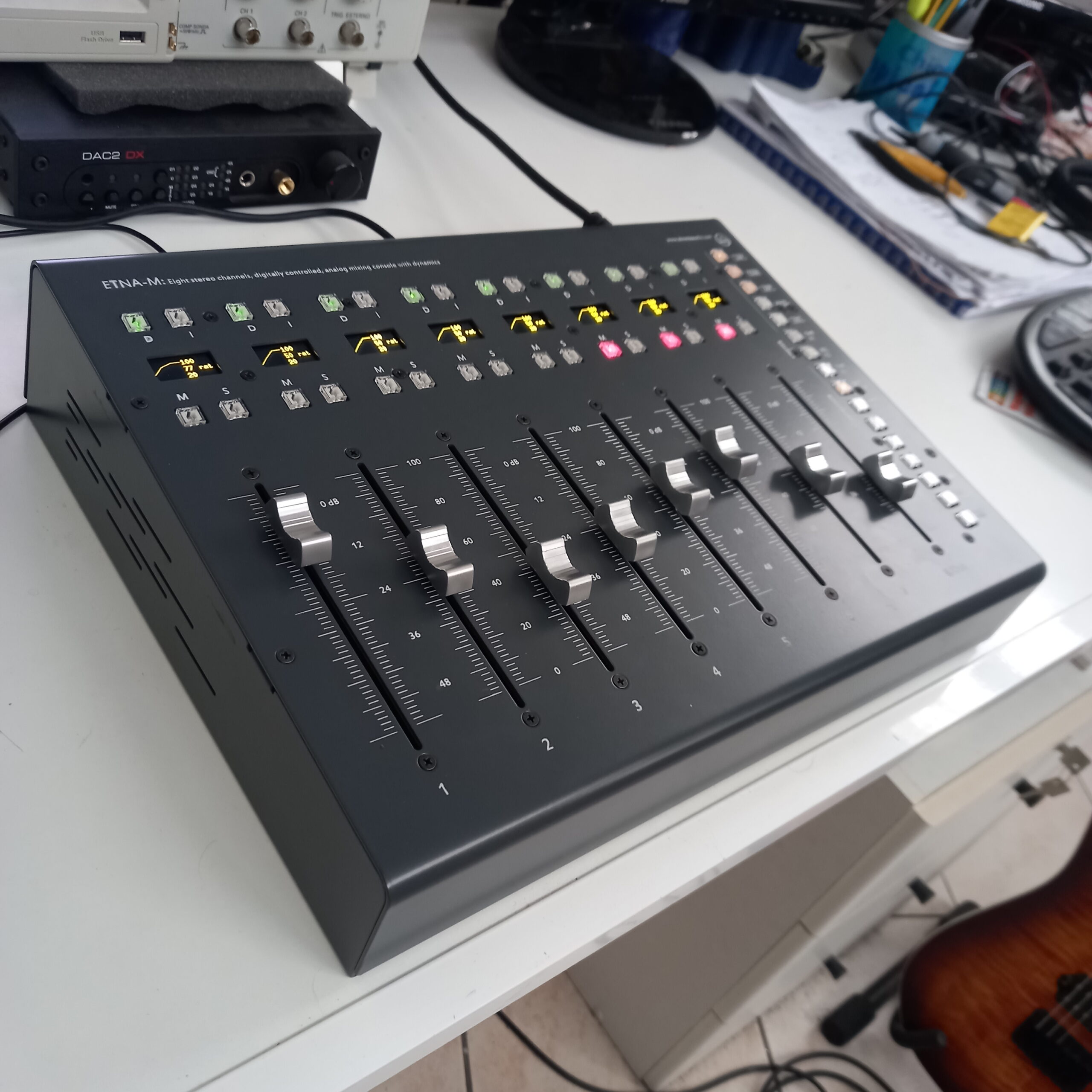
Sizes: 37 x 27 x 7 cm
Case: steel (powder-coated).
Mains: universal.
Inputs: 8 x stereo, electronically balanced.
Sends and Returns: 8 x stereo, electronically balanced.
Outputs: Carnhill audio transformers.
VCAs: Blackmer.
Summing: 2 x discrete 990 VCAs.
Input dynamics: 24dBu.
Output dynamics: 26 dBu.
Effects: full dynamics (limiter, compressor, expander, multi-mode) on each stereo channel and on master bus.
Special features: 4 x “Ducking” busses with full connectivity.
Controls: 48 x LED-buttons, 8 x 100mm motorised, touch-sensitive faders (replicated in realtime on the external editor).
Metering/Display: 8 x graphic OLED screens.
Interface to DAW: USB/MIDI standard (Mackie).
Interface to editor: USB host.
For any additional information, technical specs, questions: sales@sknoteaudio.com
Distributors, re-sellers: please write to sales@sknoteaudio.com
